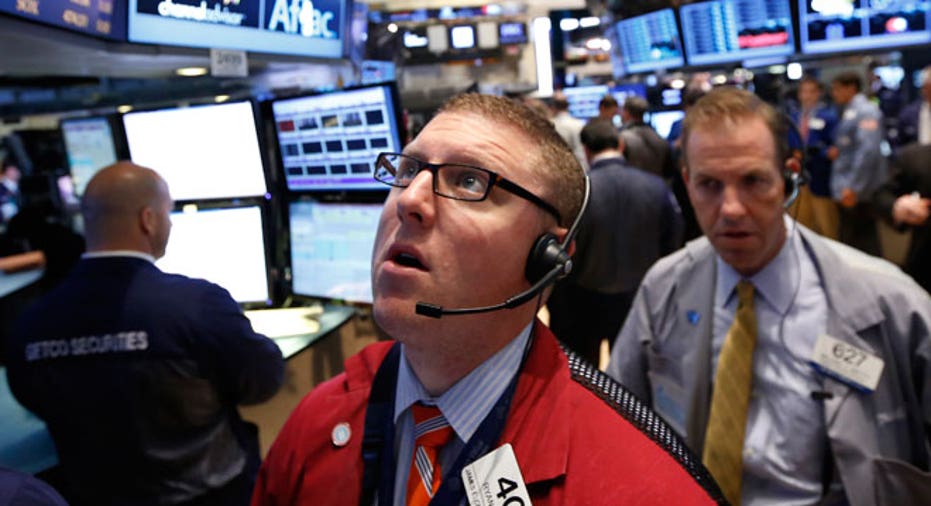Volatility Socks Stocks as Relief Rally Crumbles

After surging through most of the trading day, Wall Street put the brakes on a significant rally late in the session Tuesday as all the major U.S. averages fell firmly back in correction territory.
The Dow Jones Industrial Average shed 205 points, or 1.29% to 15666. The S&P 500 lost 25 points, or 1.34% to 1867, while the Nasdaq declined 19 points, or 0.44% to 4506. All 10 S&P 500 sectors were in negative territory.
All ten S&P 500 sectors closed the trading day in negative territory.
Today’s Markets
It looked to be a positive day on Wall Street before momentum deteriorated in the final 30 minutes of trade. At the close, the Dow saw its largest six-day point decline since October 2008, while NYSE composite volume was the highest in five months.
When all was said and done, the Dow traded within a 662-point range.
What added to the initial optimism on the Street was a move by the Chinese central bank to cut interest rates in an effort to quell investor anxiety.
The People’s Bank of China cut the nation’s benchmark interest rate by 0.25%, bringing the one-year lending rate to 4.6%. The PBoC also slashed the reserve ratio requirement for banks by 0.5 percentage points, effective September 6.
The central bank said the move was aimed at lowering corporate borrowing costs and to ensure enough liquidity for stable credit growth.
“I think it’s a real good start, but it’s on the low end of what the markets were looking for. It indicates China has stepped off the idea that markets will go it alone, and instead the government will support them. It’s not a question about how much assistance there is, now that they’ve made the commitment, it will be enough [to quell market sentiment],” Brad McMillan, chief investment officer for Commonwealth Financial Network said.
The move didn’t come in time to boost China’s equity markets, though, where investors continued to ditch their positions as worries about an economic slowdown persisted. The Shanghai Composite Index dropped 7.63%, while Japan’s Nikkei slid 3.96%. Hong Kong’s Hang Seng index, though, traded in positive territory, closing up 0.72%.
Optimism was the name of the game in Europe where traders there shrugged off China fears. The Euro Stoxx 50, which tracks large-cap companies in the eurozone, jumped 5.24%. Meanwhile, the German Dax climbed 5.47%, the French CAC 40 surged 4.74%, and the FTSE 100 rose 3.30%.
“The Chinese stock market may be caught up in its own chaos, but the rest of the global equity markets are recovering,” IG Market Analyst David Madden said in a note. “While the moves we’ve experienced this morning in Europe are encouraging, the market still has a lot of ground to make up before we’re back to normal levels.”
To that point, McMillian said from a trading perspective it makes sense to start moving money back into the equity markets. Long term, he added that if investors can stomach the volatility, five years from now the recent action won’t be more than a blip on the screen. For U.S. investors, it’s about looking to a fundamentally-solid American economy that, historically, has been able to decouple itself from the global economy.
“I wouldn’t bet against more volatility, but I think this positive momentum will be sustained,” he said. “When you look at the fundamentals in the U.S.: The economy is improving, we have a supportive environment from a central-bank perspective; lower oil prices, though hitting energy, have been an enormous stimulus to the rest of the economy. That’s not an environment in which stocks meltdown.”
To that point, traders in the U.S. looked ahead to a packed economic data calendar that should help give a more solid picture to when the Federal Reserve might look to raise interest rates for the first time since the Great Recession.
The latest data from the S&P/Case-Shiller home price index showed prices in 20 major U.S. metro areas rose 1% in June on a non-seasonally-adjusted basis. Meanwhile, form the same period a year prior, prices saw a 5% increase, which was slightly below the 5.1% expected climb.
Elsewhere, data showed consumer confidence hit its highest level since January, while new home sales saw a shallower-than-expected rise in July.
The data come on the heels of comments from Atlanta Fed President Dennis Lockhart who said just before the close of trade Monday he still expects a rate increase before the year is up. However, many on Wall Street have doubted the move will come in September as previously anticipated, in the wake of global-market turmoil – including Barclays, which pushed out its rate-hike forecast to March 2016 from September.
“With all the uncertainty, September is still a possibility, especially if we get a quick bounce back because the Fed is focused on fundamentals, which at this point show we’re at the point of raising rates,” McMillan said. “If there’s more volatility, that could result in postponing. I’m not ruling out September, but it’s certainly less probable than it was before.”
Commodity markets also turned solidly higher on Tuesday. Though still near six-and-a-half year lows, global oil prices climbed steadily. U.S. crude jumped 3.22% to $39.37 a barrel, while Brent, the international benchmark, rose 1.31% to $43.24 a barrel.
Copper rose 2.11% to $2.30 a pound. Silver fell 1% to $14.65 an ounce, while gold declined 1.46% to $1,136 a troy ounce as traders shifted positions to riskier assets on the heels of the prior session’s selloff. To that point, the yield on the benchmark 10-year Treasury bond rose 0.084 of a percentage point to 2.082%.
In currencies, the U.S. dollar rose 0.14% against the Chinese yuan, while the euro fell 1.68% against the greenback.



















